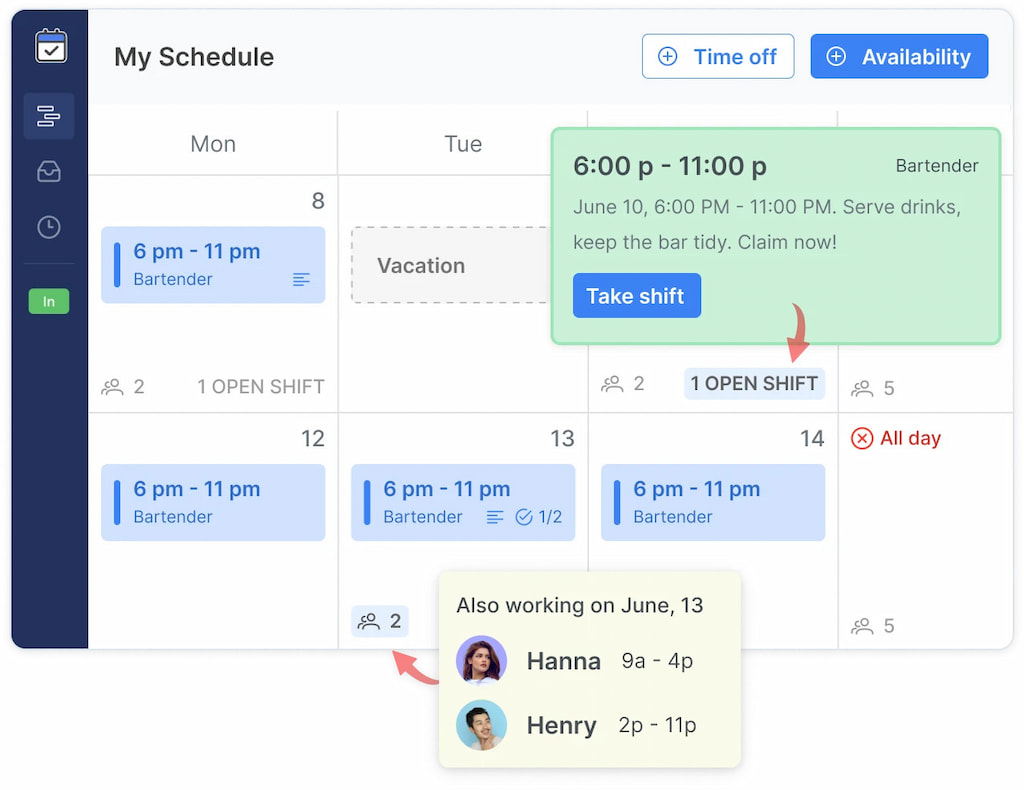Event Staff Scheduling Software: How to Choose the Best Solution for Your Team

Event staff scheduling software helps eliminate the confusion that comes with spreadsheets, emails, and sticky notes. Many event coordinators lose track of who’s working where—leading to no-shows, double bookings, or missed shifts. A good tool gives you a clear view of your schedule, sends alerts for conflicts, works on mobile, and connects with attendance tracking.
- 📅 Keep all staff schedules in one place — no version mix-ups
- 🚫 Cut down no‑shows, shift overlap, and payroll mistakes
- 💬 Boost team morale with fair, clear assignments
- 🧠 Free up managers to focus on strategy, not logistics
- 🎉 Create better guest experiences with reliable staffing
This guide covers what to look for in event staff management software, why it matters, and how to choose the right one. Tools like Shifts by Everhour make things easy with smart features, real-time access, and a simple design.
❓ Why Manual Scheduling Fails Event Teams
Event staff scheduling software helps you avoid common pitfalls:
- 🗂️ Spreadsheet chaos: Confusing versions, duplicate entries, missed shifts
- 🎭 Role mismatches: Bartenders end up ushering; untrained staff scheduled at peak times
- 📢 Poor communication: Last-minute changes slip through the cracks
- 🧾 No traceability: Payroll errors and compliance issues go unnoticed
🎯 One small mistake can throw off an entire event—hurting guest experience and your reputation. With shifting headcounts and high expectations, modern events need smarter scheduling tools.
✅ What Intelligent Event Scheduling Software Looks Like
The right platform should act as a centralized control hub:
- Real-time dashboard for shift creation, editing, and approval workflows
- Skill-based filtering to match the right team member to the right role
- Built-in scheduling conflict detection that flags double-bookings or coverage gaps instantly
- Automated notifications and reminders via app, SMS, or email
- Attendance tracking with GPS or timestamp verification
- Audit logs and version history to track changes and approvals
- Shift templates and repeat events to scale quickly for recurring gigs
Platforms like Shifts by Everhour provide teams with end-to-end scheduling tools that offer visibility, structure, and automation in one place—enabling faster decisions, fewer errors, and better events.

💡 Key Benefits of Scheduling Software for Events
| Benefit | Why It Matters |
|---|---|
| Time-saving | Automates repetitive tasks and reduces manual coordination efforts |
| Accuracy | Avoids over- or under-staffing with role and skill matching |
| Accountability | Tracks who made what change, and when |
| Communication | Real-time alerts prevent breakdowns in team coordination |
| Flexibility | Allows for quick swaps or last-minute updates with full approval tracking |
| Analytics & Planning | Analyze usage trends, time-off patterns, and plan proactively for future events |
| Compliance Ready | Provides auditable records of hours worked, roles covered, and PTO approvals |
Teams using scheduling software report saving up to 30–40% on staffing administration time, with a notable drop in last-minute issues, payroll adjustments, and staff miscommunication.
🛠️ What to Look for: Must-Have vs. Advanced Features
✅ Must-have features
- Role-based shift creation with availability insights
- Approval workflows for changes and swaps
- Conflict detection for time overlaps or under-coverage
- Calendar integrations (Google, Outlook) and mobile alerts
💡 Advanced capabilities
- Certification & training-level filters to assign qualified staff
- Payroll and time-tracking integrations
- Custom reporting dashboards for reliability and cost analysis
- Messaging tools for shift-related announcements
- API access for CRM and venue system integration
Shifts by Everhour simplifies event scheduling with drag-and-drop shifts, mobile alerts, and built-in conflict checks—perfect for fast-moving, multi-role environments.
🧭 Implementation Steps for Event Teams
Step 1: Audit your existing process
Start with a clear understanding of your current system:
- How do you assign shifts today?
- What errors have occurred recently?
- What feedback do team leads provide about coverage gaps?
- How long does it take to update or reassign?
Step 2: Define staffing rules
Establish event-specific requirements:
- Minimum roles required per area or shift
- Required certifications or training for certain positions
- Shift length standards, break timing, and overtime policy
- Approval chains and edit permissions by department
Step 3: Select the right platform
🚀 Tool comparison checklist
Use this checklist to evaluate which event staff scheduling software fits your needs:
| Criteria | Why It Matters |
|---|---|
| Budget Alignment | Scales with event size and doesn’t exceed department limits |
| Team Size Fit | Works for both small crews and large-scale deployments |
| Mobile Usability | Ensures field staff can access updates and schedules instantly |
| Integration Capabilities | Syncs with payroll, HR systems, and other critical platforms |
| Customization & Templates | Supports recurring events and varied shift structures |
| User Support & Training | Offers onboarding help, documentation, and live support |
Evaluate 2–3 options using this table before committing to a platform like Shifts by Everhour. Consider your team size, event frequency, and operational complexity when comparing solutions.
Recommendation: Choose Shifts by Everhour for real-time visibility, fast setup, and event-specific flexibility.
Step 4: Run a controlled pilot
Deploy the software for a mid-size or recurring event. Evaluate:
- Setup time
- User adoption
- Frequency of errors or overrides
Step 5: Train Teams and Standardize
- Provide 15-minute training videos or 1-pagers
- Host a live Q&A or staff training session
- Embed tools into onboarding for seasonal/freelance hires
Step 6: Measure Results and Optimize
Post-event analysis should include:
- Time saved by coordinators
- Reduction in missed shifts
- Team feedback
- Budget impact through overtime reduction or more efficient staffing ratios
🙋 FAQ: Common Concerns & Solutions
“Our team is small—do we really need software?”
Even small teams benefit. One missed or duplicate shift can disrupt your entire event.
“We work with different freelancers each time.”
Modern tools like Shifts by Everhour allow quick invite links, profile-based filtering, and self-service availability updates.
“Will this create extra work during busy seasons?”
Actually, it reduces it. You’ll spend less time reacting to issues and more time improving experience and performance.
“Can our non-technical staff use it?”
Yes. Clean UX and mobile-first design mean anyone with a smartphone can view, confirm, and update schedules.
“What if something changes day-of?”
All changes are tracked, sent out instantly, and reflected in everyone’s dashboard. No more calls, texts, or scribbled paper edits.
📊 Real-World Impacts
- 98% fewer missed shifts through proactive conflict detection
- 2x faster shift setup with templates and repeat event support
- 20–30% reduction in admin time spent per event
- Increased satisfaction from staff who feel heard, supported, and in control of their assignments
🔚 Final Thoughts & Call-to-Action
Event staff scheduling can go from chaotic to seamless with the right platform.
✨ Top 3 takeaways:
- 🔄 Automate shift creation and prevent scheduling mistakes
- 📱 Empower staff with mobile access and real-time updates
- ⏱️ Cut admin time while boosting team morale
🚀 You’ll unlock:
- ✅ Clear, automated workflows
- 👥 Better coverage with fewer people
- 😊 Happier teams who know exactly where and when they’re needed
- 📊 Audit-ready records for payroll and compliance
🧭 Take the pressure off before your next event hits crunch time.
Start your free trial of Shifts by Everhour today or request a custom demo—and run your next event smoother, smarter, and stress-free.
Benefit from using top scheduling apps for work!
